Detailed Hydrogeology Report: Analysis of Bowral's Geological Layers
VerifiedAdded on 2023/03/21
|6
|1496
|26
Report
AI Summary
This hydrogeology report provides an analysis of the geological layers in Bowral, focusing on the Finniss River Group and Katherine River Group, including their subdivisions like the Kombolgie Formations and Henwood Creek Volcanic Member. It discusses the principles of stratigraphy, such as original horizontality, lateral continuity, and superposition, explaining how geologists evaluate rock layers. The report also defines aquifers, highlighting their composition, porosity, permeability, and potential for groundwater pollution. It differentiates between confined and unconfined aquifers, detailing their recharge mechanisms and the influence of various factors on the water table depth. Additionally, the report examines saturated and unsaturated zones, emphasizing the importance of the unsaturated zone for environmental processes. Finally, it briefly discusses the Wingecarribee Reservoir and operational boreholes in Bowral, underlining their significance for water provision. Desklib offers more resources like this for students.
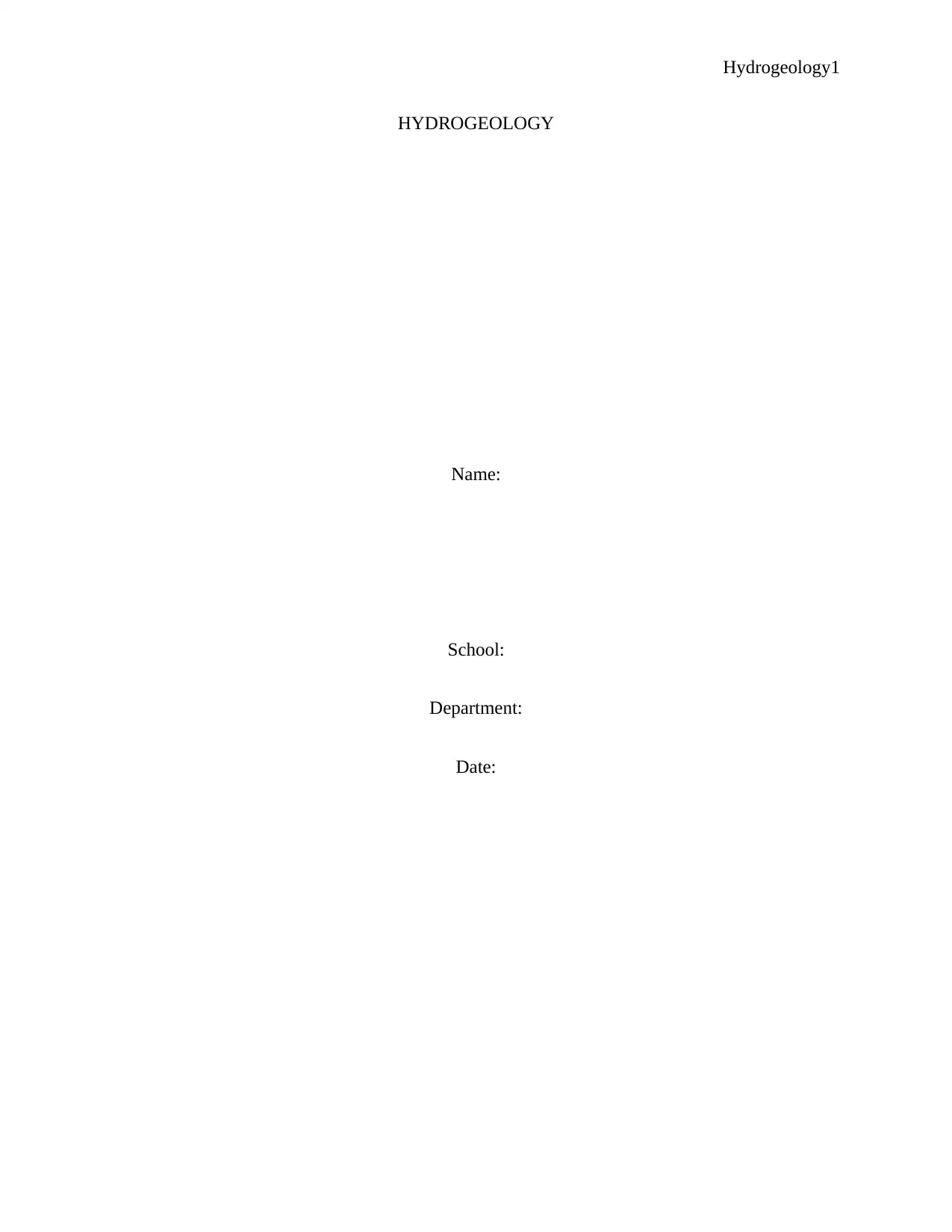
Hydrogeology1
HYDROGEOLOGY
Name:
School:
Department:
Date:
HYDROGEOLOGY
Name:
School:
Department:
Date:
Paraphrase This Document
Need a fresh take? Get an instant paraphrase of this document with our AI Paraphraser
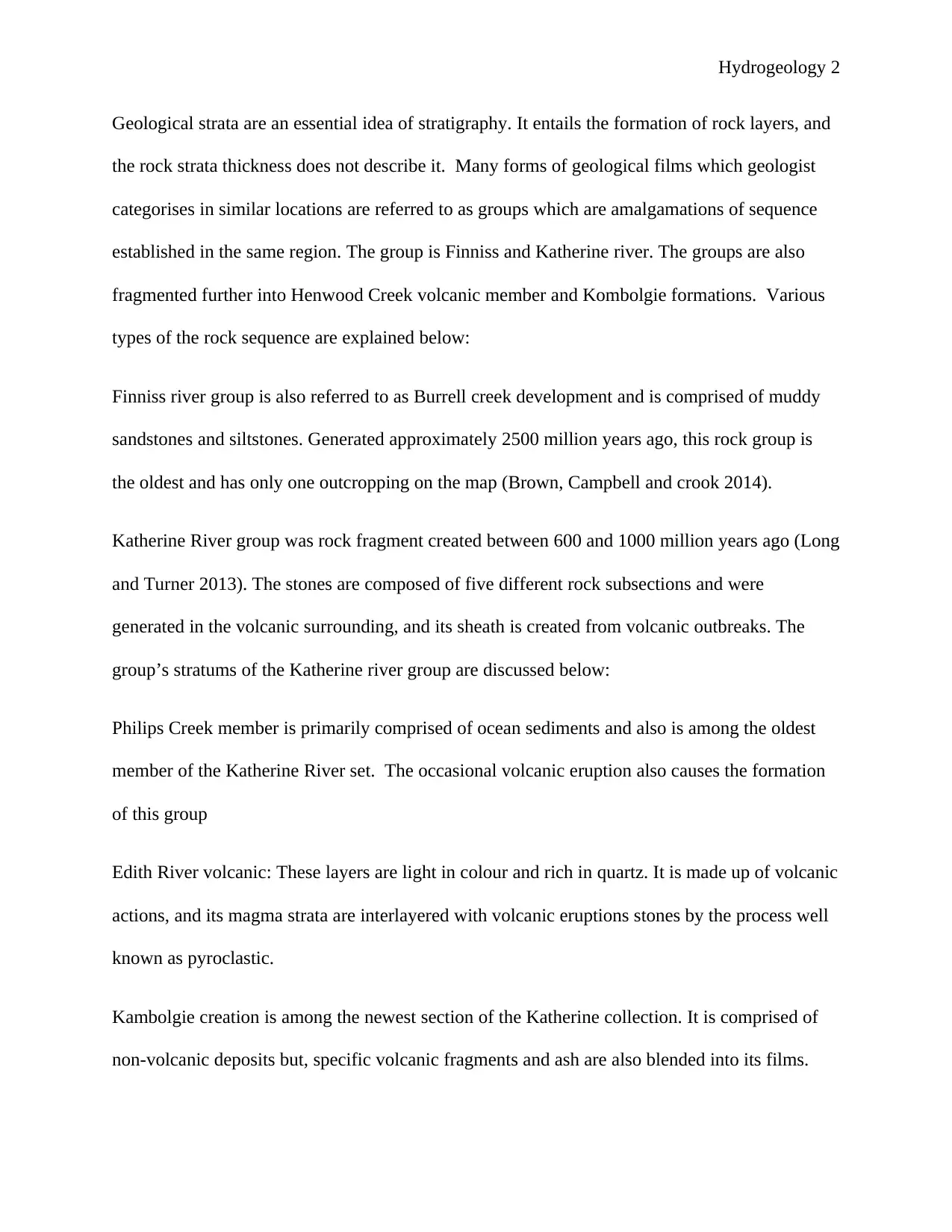
Hydrogeology 2
Geological strata are an essential idea of stratigraphy. It entails the formation of rock layers, and
the rock strata thickness does not describe it. Many forms of geological films which geologist
categorises in similar locations are referred to as groups which are amalgamations of sequence
established in the same region. The group is Finniss and Katherine river. The groups are also
fragmented further into Henwood Creek volcanic member and Kombolgie formations. Various
types of the rock sequence are explained below:
Finniss river group is also referred to as Burrell creek development and is comprised of muddy
sandstones and siltstones. Generated approximately 2500 million years ago, this rock group is
the oldest and has only one outcropping on the map (Brown, Campbell and crook 2014).
Katherine River group was rock fragment created between 600 and 1000 million years ago (Long
and Turner 2013). The stones are composed of five different rock subsections and were
generated in the volcanic surrounding, and its sheath is created from volcanic outbreaks. The
group’s stratums of the Katherine river group are discussed below:
Philips Creek member is primarily comprised of ocean sediments and also is among the oldest
member of the Katherine River set. The occasional volcanic eruption also causes the formation
of this group
Edith River volcanic: These layers are light in colour and rich in quartz. It is made up of volcanic
actions, and its magma strata are interlayered with volcanic eruptions stones by the process well
known as pyroclastic.
Kambolgie creation is among the newest section of the Katherine collection. It is comprised of
non-volcanic deposits but, specific volcanic fragments and ash are also blended into its films.
Geological strata are an essential idea of stratigraphy. It entails the formation of rock layers, and
the rock strata thickness does not describe it. Many forms of geological films which geologist
categorises in similar locations are referred to as groups which are amalgamations of sequence
established in the same region. The group is Finniss and Katherine river. The groups are also
fragmented further into Henwood Creek volcanic member and Kombolgie formations. Various
types of the rock sequence are explained below:
Finniss river group is also referred to as Burrell creek development and is comprised of muddy
sandstones and siltstones. Generated approximately 2500 million years ago, this rock group is
the oldest and has only one outcropping on the map (Brown, Campbell and crook 2014).
Katherine River group was rock fragment created between 600 and 1000 million years ago (Long
and Turner 2013). The stones are composed of five different rock subsections and were
generated in the volcanic surrounding, and its sheath is created from volcanic outbreaks. The
group’s stratums of the Katherine river group are discussed below:
Philips Creek member is primarily comprised of ocean sediments and also is among the oldest
member of the Katherine River set. The occasional volcanic eruption also causes the formation
of this group
Edith River volcanic: These layers are light in colour and rich in quartz. It is made up of volcanic
actions, and its magma strata are interlayered with volcanic eruptions stones by the process well
known as pyroclastic.
Kambolgie creation is among the newest section of the Katherine collection. It is comprised of
non-volcanic deposits but, specific volcanic fragments and ash are also blended into its films.
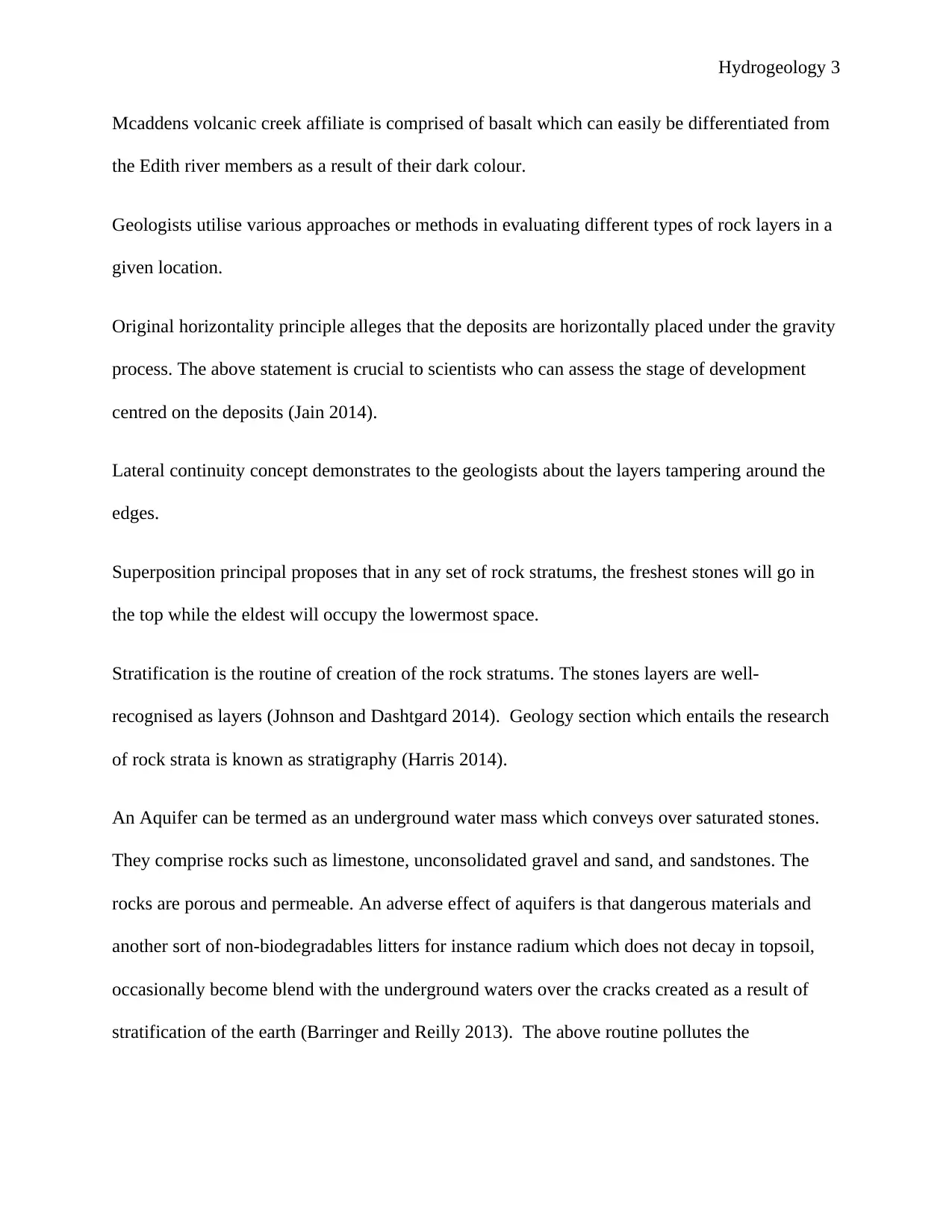
Hydrogeology 3
Mcaddens volcanic creek affiliate is comprised of basalt which can easily be differentiated from
the Edith river members as a result of their dark colour.
Geologists utilise various approaches or methods in evaluating different types of rock layers in a
given location.
Original horizontality principle alleges that the deposits are horizontally placed under the gravity
process. The above statement is crucial to scientists who can assess the stage of development
centred on the deposits (Jain 2014).
Lateral continuity concept demonstrates to the geologists about the layers tampering around the
edges.
Superposition principal proposes that in any set of rock stratums, the freshest stones will go in
the top while the eldest will occupy the lowermost space.
Stratification is the routine of creation of the rock stratums. The stones layers are well-
recognised as layers (Johnson and Dashtgard 2014). Geology section which entails the research
of rock strata is known as stratigraphy (Harris 2014).
An Aquifer can be termed as an underground water mass which conveys over saturated stones.
They comprise rocks such as limestone, unconsolidated gravel and sand, and sandstones. The
rocks are porous and permeable. An adverse effect of aquifers is that dangerous materials and
another sort of non-biodegradables litters for instance radium which does not decay in topsoil,
occasionally become blend with the underground waters over the cracks created as a result of
stratification of the earth (Barringer and Reilly 2013). The above routine pollutes the
Mcaddens volcanic creek affiliate is comprised of basalt which can easily be differentiated from
the Edith river members as a result of their dark colour.
Geologists utilise various approaches or methods in evaluating different types of rock layers in a
given location.
Original horizontality principle alleges that the deposits are horizontally placed under the gravity
process. The above statement is crucial to scientists who can assess the stage of development
centred on the deposits (Jain 2014).
Lateral continuity concept demonstrates to the geologists about the layers tampering around the
edges.
Superposition principal proposes that in any set of rock stratums, the freshest stones will go in
the top while the eldest will occupy the lowermost space.
Stratification is the routine of creation of the rock stratums. The stones layers are well-
recognised as layers (Johnson and Dashtgard 2014). Geology section which entails the research
of rock strata is known as stratigraphy (Harris 2014).
An Aquifer can be termed as an underground water mass which conveys over saturated stones.
They comprise rocks such as limestone, unconsolidated gravel and sand, and sandstones. The
rocks are porous and permeable. An adverse effect of aquifers is that dangerous materials and
another sort of non-biodegradables litters for instance radium which does not decay in topsoil,
occasionally become blend with the underground waters over the cracks created as a result of
stratification of the earth (Barringer and Reilly 2013). The above routine pollutes the
⊘ This is a preview!⊘
Do you want full access?
Subscribe today to unlock all pages.

Trusted by 1+ million students worldwide
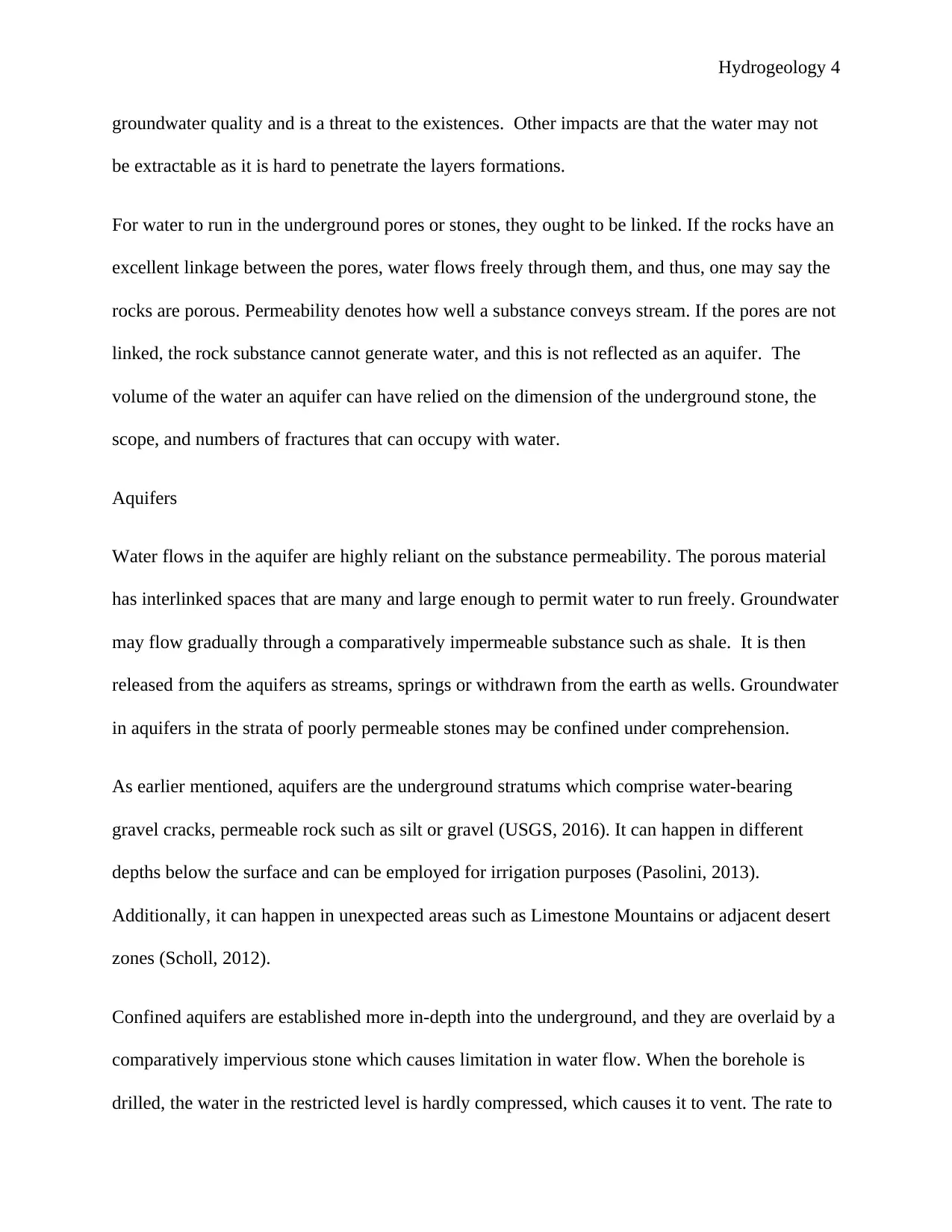
Hydrogeology 4
groundwater quality and is a threat to the existences. Other impacts are that the water may not
be extractable as it is hard to penetrate the layers formations.
For water to run in the underground pores or stones, they ought to be linked. If the rocks have an
excellent linkage between the pores, water flows freely through them, and thus, one may say the
rocks are porous. Permeability denotes how well a substance conveys stream. If the pores are not
linked, the rock substance cannot generate water, and this is not reflected as an aquifer. The
volume of the water an aquifer can have relied on the dimension of the underground stone, the
scope, and numbers of fractures that can occupy with water.
Aquifers
Water flows in the aquifer are highly reliant on the substance permeability. The porous material
has interlinked spaces that are many and large enough to permit water to run freely. Groundwater
may flow gradually through a comparatively impermeable substance such as shale. It is then
released from the aquifers as streams, springs or withdrawn from the earth as wells. Groundwater
in aquifers in the strata of poorly permeable stones may be confined under comprehension.
As earlier mentioned, aquifers are the underground stratums which comprise water-bearing
gravel cracks, permeable rock such as silt or gravel (USGS, 2016). It can happen in different
depths below the surface and can be employed for irrigation purposes (Pasolini, 2013).
Additionally, it can happen in unexpected areas such as Limestone Mountains or adjacent desert
zones (Scholl, 2012).
Confined aquifers are established more in-depth into the underground, and they are overlaid by a
comparatively impervious stone which causes limitation in water flow. When the borehole is
drilled, the water in the restricted level is hardly compressed, which causes it to vent. The rate to
groundwater quality and is a threat to the existences. Other impacts are that the water may not
be extractable as it is hard to penetrate the layers formations.
For water to run in the underground pores or stones, they ought to be linked. If the rocks have an
excellent linkage between the pores, water flows freely through them, and thus, one may say the
rocks are porous. Permeability denotes how well a substance conveys stream. If the pores are not
linked, the rock substance cannot generate water, and this is not reflected as an aquifer. The
volume of the water an aquifer can have relied on the dimension of the underground stone, the
scope, and numbers of fractures that can occupy with water.
Aquifers
Water flows in the aquifer are highly reliant on the substance permeability. The porous material
has interlinked spaces that are many and large enough to permit water to run freely. Groundwater
may flow gradually through a comparatively impermeable substance such as shale. It is then
released from the aquifers as streams, springs or withdrawn from the earth as wells. Groundwater
in aquifers in the strata of poorly permeable stones may be confined under comprehension.
As earlier mentioned, aquifers are the underground stratums which comprise water-bearing
gravel cracks, permeable rock such as silt or gravel (USGS, 2016). It can happen in different
depths below the surface and can be employed for irrigation purposes (Pasolini, 2013).
Additionally, it can happen in unexpected areas such as Limestone Mountains or adjacent desert
zones (Scholl, 2012).
Confined aquifers are established more in-depth into the underground, and they are overlaid by a
comparatively impervious stone which causes limitation in water flow. When the borehole is
drilled, the water in the restricted level is hardly compressed, which causes it to vent. The rate to
Paraphrase This Document
Need a fresh take? Get an instant paraphrase of this document with our AI Paraphraser
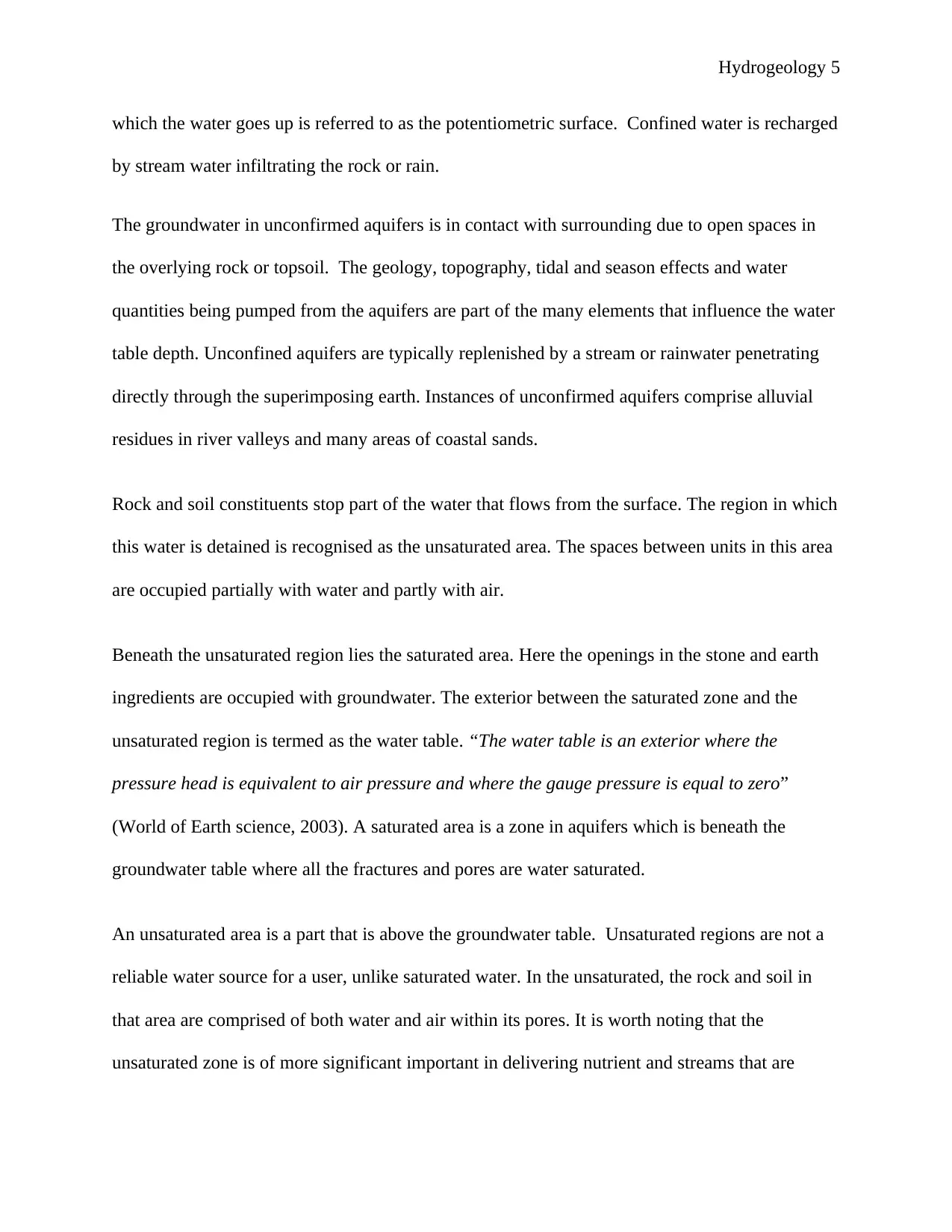
Hydrogeology 5
which the water goes up is referred to as the potentiometric surface. Confined water is recharged
by stream water infiltrating the rock or rain.
The groundwater in unconfirmed aquifers is in contact with surrounding due to open spaces in
the overlying rock or topsoil. The geology, topography, tidal and season effects and water
quantities being pumped from the aquifers are part of the many elements that influence the water
table depth. Unconfined aquifers are typically replenished by a stream or rainwater penetrating
directly through the superimposing earth. Instances of unconfirmed aquifers comprise alluvial
residues in river valleys and many areas of coastal sands.
Rock and soil constituents stop part of the water that flows from the surface. The region in which
this water is detained is recognised as the unsaturated area. The spaces between units in this area
are occupied partially with water and partly with air.
Beneath the unsaturated region lies the saturated area. Here the openings in the stone and earth
ingredients are occupied with groundwater. The exterior between the saturated zone and the
unsaturated region is termed as the water table. “The water table is an exterior where the
pressure head is equivalent to air pressure and where the gauge pressure is equal to zero”
(World of Earth science, 2003). A saturated area is a zone in aquifers which is beneath the
groundwater table where all the fractures and pores are water saturated.
An unsaturated area is a part that is above the groundwater table. Unsaturated regions are not a
reliable water source for a user, unlike saturated water. In the unsaturated, the rock and soil in
that area are comprised of both water and air within its pores. It is worth noting that the
unsaturated zone is of more significant important in delivering nutrient and streams that are
which the water goes up is referred to as the potentiometric surface. Confined water is recharged
by stream water infiltrating the rock or rain.
The groundwater in unconfirmed aquifers is in contact with surrounding due to open spaces in
the overlying rock or topsoil. The geology, topography, tidal and season effects and water
quantities being pumped from the aquifers are part of the many elements that influence the water
table depth. Unconfined aquifers are typically replenished by a stream or rainwater penetrating
directly through the superimposing earth. Instances of unconfirmed aquifers comprise alluvial
residues in river valleys and many areas of coastal sands.
Rock and soil constituents stop part of the water that flows from the surface. The region in which
this water is detained is recognised as the unsaturated area. The spaces between units in this area
are occupied partially with water and partly with air.
Beneath the unsaturated region lies the saturated area. Here the openings in the stone and earth
ingredients are occupied with groundwater. The exterior between the saturated zone and the
unsaturated region is termed as the water table. “The water table is an exterior where the
pressure head is equivalent to air pressure and where the gauge pressure is equal to zero”
(World of Earth science, 2003). A saturated area is a zone in aquifers which is beneath the
groundwater table where all the fractures and pores are water saturated.
An unsaturated area is a part that is above the groundwater table. Unsaturated regions are not a
reliable water source for a user, unlike saturated water. In the unsaturated, the rock and soil in
that area are comprised of both water and air within its pores. It is worth noting that the
unsaturated zone is of more significant important in delivering nutrient and streams that are
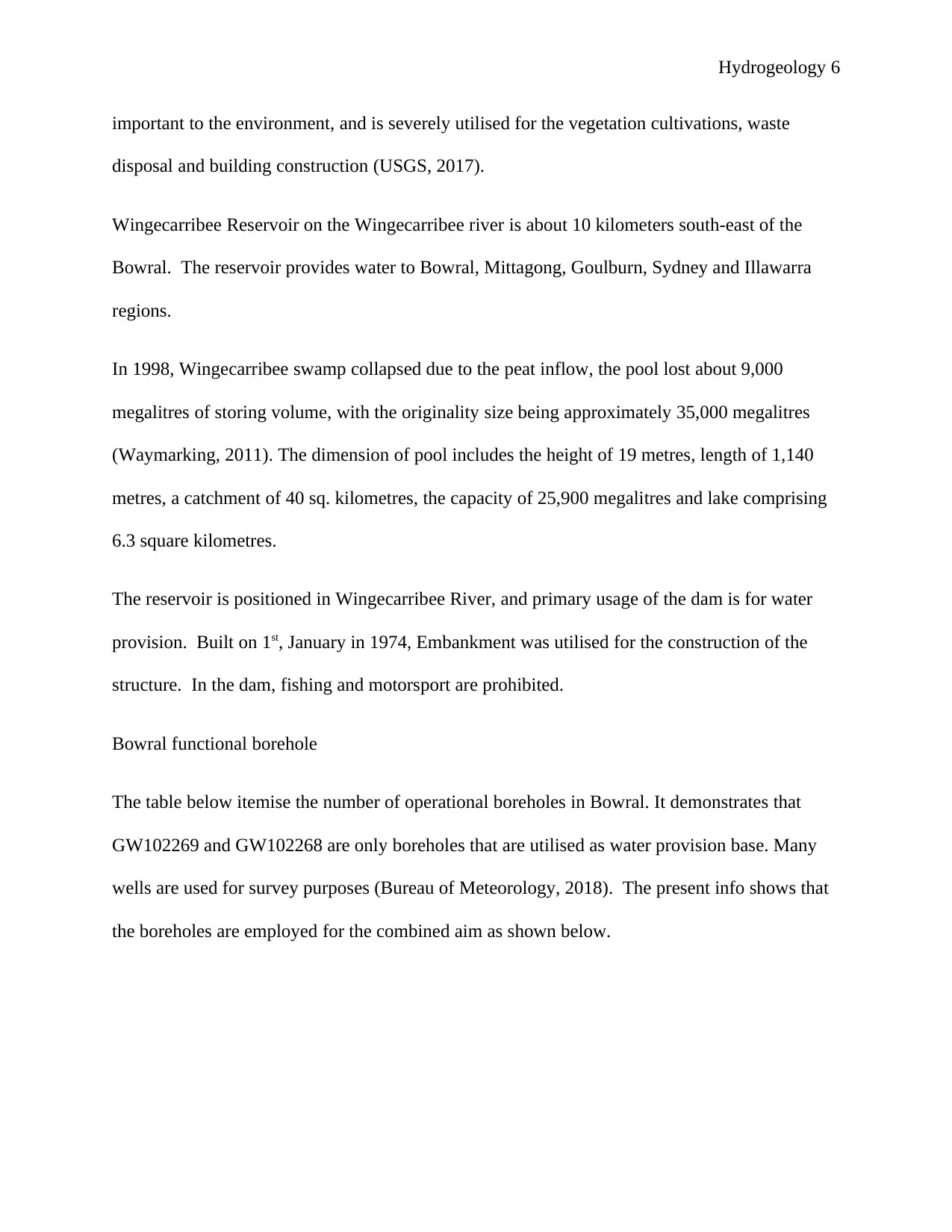
Hydrogeology 6
important to the environment, and is severely utilised for the vegetation cultivations, waste
disposal and building construction (USGS, 2017).
Wingecarribee Reservoir on the Wingecarribee river is about 10 kilometers south-east of the
Bowral. The reservoir provides water to Bowral, Mittagong, Goulburn, Sydney and Illawarra
regions.
In 1998, Wingecarribee swamp collapsed due to the peat inflow, the pool lost about 9,000
megalitres of storing volume, with the originality size being approximately 35,000 megalitres
(Waymarking, 2011). The dimension of pool includes the height of 19 metres, length of 1,140
metres, a catchment of 40 sq. kilometres, the capacity of 25,900 megalitres and lake comprising
6.3 square kilometres.
The reservoir is positioned in Wingecarribee River, and primary usage of the dam is for water
provision. Built on 1st, January in 1974, Embankment was utilised for the construction of the
structure. In the dam, fishing and motorsport are prohibited.
Bowral functional borehole
The table below itemise the number of operational boreholes in Bowral. It demonstrates that
GW102269 and GW102268 are only boreholes that are utilised as water provision base. Many
wells are used for survey purposes (Bureau of Meteorology, 2018). The present info shows that
the boreholes are employed for the combined aim as shown below.
important to the environment, and is severely utilised for the vegetation cultivations, waste
disposal and building construction (USGS, 2017).
Wingecarribee Reservoir on the Wingecarribee river is about 10 kilometers south-east of the
Bowral. The reservoir provides water to Bowral, Mittagong, Goulburn, Sydney and Illawarra
regions.
In 1998, Wingecarribee swamp collapsed due to the peat inflow, the pool lost about 9,000
megalitres of storing volume, with the originality size being approximately 35,000 megalitres
(Waymarking, 2011). The dimension of pool includes the height of 19 metres, length of 1,140
metres, a catchment of 40 sq. kilometres, the capacity of 25,900 megalitres and lake comprising
6.3 square kilometres.
The reservoir is positioned in Wingecarribee River, and primary usage of the dam is for water
provision. Built on 1st, January in 1974, Embankment was utilised for the construction of the
structure. In the dam, fishing and motorsport are prohibited.
Bowral functional borehole
The table below itemise the number of operational boreholes in Bowral. It demonstrates that
GW102269 and GW102268 are only boreholes that are utilised as water provision base. Many
wells are used for survey purposes (Bureau of Meteorology, 2018). The present info shows that
the boreholes are employed for the combined aim as shown below.
⊘ This is a preview!⊘
Do you want full access?
Subscribe today to unlock all pages.

Trusted by 1+ million students worldwide
1 out of 6
Your All-in-One AI-Powered Toolkit for Academic Success.
+13062052269
info@desklib.com
Available 24*7 on WhatsApp / Email
![[object Object]](/_next/static/media/star-bottom.7253800d.svg)
Unlock your academic potential
Copyright © 2020–2025 A2Z Services. All Rights Reserved. Developed and managed by ZUCOL.
